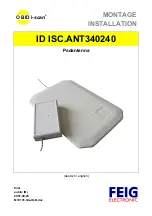
Tech Support:
www.steppir.com/support
Tel: 425.891.6134
support@steppir.com
Page 51
Read the SDA-100 Operators Manual so that you are familiar with operation of the controller. You will
also need an ohm meter or continuity tester for most of these tests. At this time the controller should
NOT be connected to your radio or computer. Also, the coax jumper cables and fiberglass poles should
not be installed on the antenna.
1. With the control cable NOT CONNECTED to the controller, turn the controller on. It should read
“Manual Mode Elements Home”. If not, push the “Retract” button. After the controller is fin-
ished tuning it will turn off. You will need to turn the controller back on. The controller will
now read “Manual Mode Elements Home”.
2. The next step is to test that each of the elements will extend their copper tapes out properly.
3. ENSURE THAT ALL THE ELEMENTS ARE CLEAR OF ANY OBSTRUCTIONS. The copper tape will
be extended out from both sides of each EHU for approximately 6 inches.
4. Go into Setup mode and select “Create, Modify”.
5. Now CONNECT the control cable to the controller.
6. Select each element (you can only do one at a time), Ref, DVR, D1 and extend them to around
16” as indicated on the controller display. There actually will be approximately 3 inches of cop-
per strip protruding out of each side of the EHU as shown in
figure 5.30
. This will allow you to
put an ohm meter probe on the copper tapes during the tests. Clarification of the abbreviations
on the screen of the SDA 100 controller—REF is the reflector, DVR is the driven element (6-
20m), and D1 is the director.
CHAPTER FIVE
SECTION 5.3
WIRING THE CONNECTOR JUNCTION BOX (continued)
WIRING TEST
7. If at this point if any of the tapes do not extend, or the individual EHU/element does not corre-
spond to the correct controller description, (I.E.: The Antenna Reflector is controlled by the REF
position on the controller.) STOP, retract the elements, disconnect the control cable and cor-
rect any wiring errors. Then start at the beginning of these instructions.
8. Now DISCONNECT the control cable BEFORE exiting “Create, Modify”. This is to prevent the
elements from moving when changing the controller to the first test frequency. Exit “Create,
Modify” by pushing the “Setup” button.
9. Set the controller to the “Normal” direction by pushing the button labeled “Norm”. The green
LED next to the button should light.
10. Set the controller to any frequency in the 20m band (14.000-14.350mhz).
11. When the controller indicates it is no longer trying to move the elements (the LED labeled
“Tuning” will stop flashing) RECONNECT the control cable again.
12. Set your ohm meter to a low ohms scale (around 200 ohms or so).
FIG. 5.30
















































